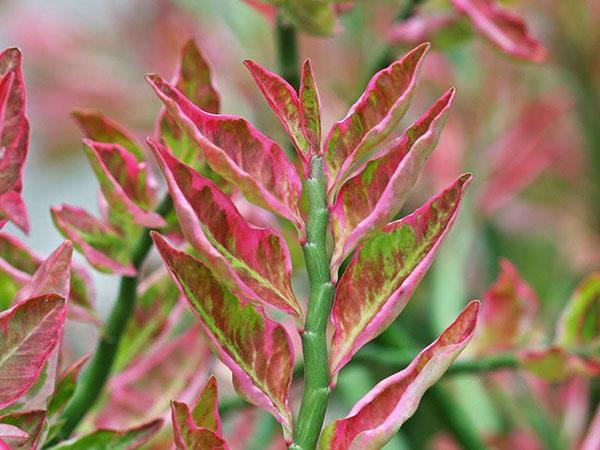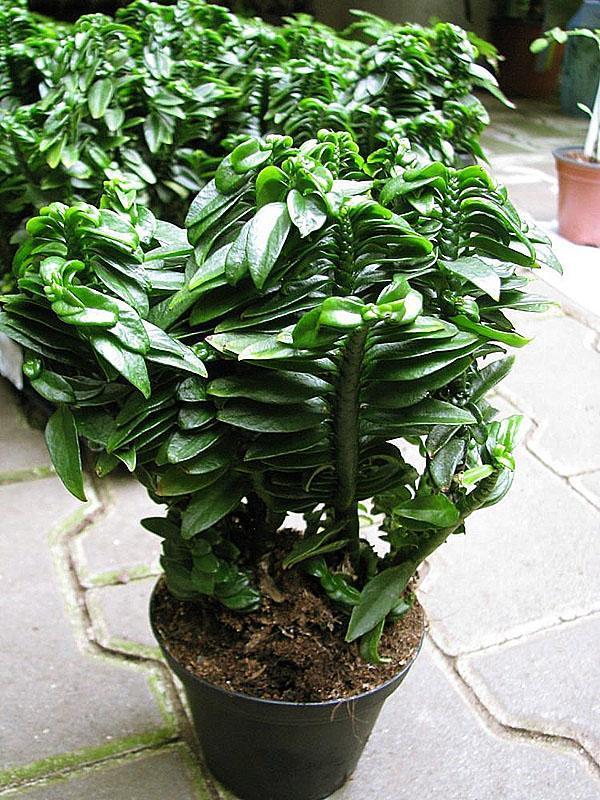Growing pedilanthus at home
 Among indoor plants, there are many people from the tropics and subtropical regions. No exception and pedilanthus, turning into a large green decoration at home. In the pot culture, several varieties of the flower are grown, which are loved by their dense leaves, powerful green stems and umbrella inflorescences of pinkish-red flowers. It is to their shape, reminiscent of an elegant silk shoe, that the flower owes its name.
Among indoor plants, there are many people from the tropics and subtropical regions. No exception and pedilanthus, turning into a large green decoration at home. In the pot culture, several varieties of the flower are grown, which are loved by their dense leaves, powerful green stems and umbrella inflorescences of pinkish-red flowers. It is to their shape, reminiscent of an elegant silk shoe, that the flower owes its name.
In nature, a plant, depending on the species, can reach a height of 50-200 cm, have erect and lodging stems, which invariably become bare as they grow. One glance at them is enough to understand why in their homeland pedilanthus is called "the stairs of St. Jacob", "the devil's ridge" or "zigzag plant". The flower stems are fancifully broken, resembling a flight of stairs or lightning.
At home, pedilanthus is lower than in nature, and flower growers are less likely to observe winter bloom.
However, this does not upset lovers of subtropical culture, because large specimens are less decorative, and crowns of unusual flowers on the shoots are successfully replaced by variegated foliage with shades of white, green and pink.

Lighting for pedilanthus at home
 An inhabitant of the dry subtropics of North and Central America, pedilanthus in nature takes root on sunny rocky slopes, where other plants lack nutrients and moisture. A hardy large plant in behavior is similar to succulents, which accumulate life-giving moisture in the stems.
An inhabitant of the dry subtropics of North and Central America, pedilanthus in nature takes root on sunny rocky slopes, where other plants lack nutrients and moisture. A hardy large plant in behavior is similar to succulents, which accumulate life-giving moisture in the stems.
Lighting for pedilanthus in room conditions should be close to natural. Western or eastern windows are best suited for culture, where the flower is under a bright, but diffused light. Here the plant appears in all its glory.
On the north side, especially in the autumn-winter period, the flower will suffer from a lack of sunlight, in which variegated varieties lose their brightness, the pink tint disappears from the leaf plates, and the white is gradually replaced by green.
On the southern windows, optimal conditions for pedilanthus are created in spring, winter and autumn. In the summer, there is a risk of overheating, to which the flower responds by dropping or lightening the foliage. If there is no other place, on sunny days, the plant is provided with shading or transferred further from the window.
The pedilanthus flower is a subtropical plant that naturally lives in conditions of long daylight hours. In the middle lane from mid-autumn to April, he needs a backlight, for which it is more correct to use special phyto-lamps.
Pedilanthus content temperature
 When growing pedilanthus at home, do not forget that this is a thermophilic plant that responds negatively to hypothermia, but perfectly tolerates temperatures up to + 25-30 ° C. In summer, a flower pot can be safely taken out into the air, covering it from precipitation and direct sunlight.
When growing pedilanthus at home, do not forget that this is a thermophilic plant that responds negatively to hypothermia, but perfectly tolerates temperatures up to + 25-30 ° C. In summer, a flower pot can be safely taken out into the air, covering it from precipitation and direct sunlight.
If the plant is kept in a room, the room should be regularly ventilated.
Pedilanthus loves fresh air, but is afraid of drafts and is unlikely to take root in the kitchen, where the concentration of combustion products is too high:
- In the warm season, the optimum temperature for keeping pedilanthus is +25 ° C. On hotter days, the flower needs more moisture, oxygen and sun protection.
- When it gets colder outside and the duration of daylight decreases, the plant feels better at + 15-18 ° C, but not below. At this time, watering is reduced, and the plant is additionally highlighted.
Pedilanthus watering mode
 Although in nature pedilanthus is not spoiled by an abundance of moisture, in room conditions its watering should be regular:
Although in nature pedilanthus is not spoiled by an abundance of moisture, in room conditions its watering should be regular:
- the summer regime of pedilanthus irrigation provides for 2–4 sessions of soil moistening per week;
- in winter, the flower should be watered no more than 2 times every 10 days.
The sign that the plant needs moisture is the drying of the surface. Excess water, especially at a reduced temperature of the pedilanthus content, threatens with root rot. The flower signals a chronic moisture deficit by yellowing and falling leaves.
Soil selection, fertilization and feeding of pedilanthus
 A native of dry subtropics is not very picky in the soil. When choosing a soil for pedilanthus, attention is paid to moderate nutritional value, good aeration, structuredness and moisture conductivity.
A native of dry subtropics is not very picky in the soil. When choosing a soil for pedilanthus, attention is paid to moderate nutritional value, good aeration, structuredness and moisture conductivity.
Among the ready-made mixtures, you can choose a universal soil for indoor decorative deciduous crops. If this is not possible, the substrate is made independently, mixing:
- 3 pieces of garden land;
- 1 part peat cleared of coarse inclusions;
- 1 part washed coarse sand.
For a flower, stagnation of moisture is dangerous, in order to avoid it, a powerful one is poured onto the bottom of the pot drainage layer.
On top of the soil, another layer of fine gravel or pebbles is made. This measure will help conserve moisture, prevent soil salinization and keep it loose for a long time.
 When growing pedilanthus, it is important not only to choose the right soil, but also fertilizers; fertilizing a flower should contain a little nitrogen and a full range of trace elements and minerals. The culture needs additional nutrition from April to September, while the active growing season lasts. Feeding pedilanthus is carried out 1-2 times a month. An excess of nitrogen can lead to the loss of the variegated color of the leaves, it is possible that the root system is damaged by rot.
When growing pedilanthus, it is important not only to choose the right soil, but also fertilizers; fertilizing a flower should contain a little nitrogen and a full range of trace elements and minerals. The culture needs additional nutrition from April to September, while the active growing season lasts. Feeding pedilanthus is carried out 1-2 times a month. An excess of nitrogen can lead to the loss of the variegated color of the leaves, it is possible that the root system is damaged by rot.
Difficulties in keeping pedilanthus at home
 Despite its exotic appearance, pedilanthus is unpretentious and gets along well with all indoor plants. The problems that arise most often relate to violations of the rules of care and maintenance, which include:
Despite its exotic appearance, pedilanthus is unpretentious and gets along well with all indoor plants. The problems that arise most often relate to violations of the rules of care and maintenance, which include:
- lack of sunlight, due to which the leaves lose their decorative effect, become smaller and crumble;
- excessively dry air and moisture deficiency, causing yellowing of foliage and its loss;
- chronic overflow, leading to the appearance of rot and soil pests;
- cold air, causing freezing of the tops of shoots and leaves.
Among the pests that most often affect the indoor flower, one can name the spider mite, mealybugs and aphids, if the plant was in the open air on summer days.
Care must be taken when caring for a pedilanthus; contact of flower sap on sensitive skin can cause irritation, redness, swelling and itching. Therefore, when trimming and planting, the grower will need gloves.